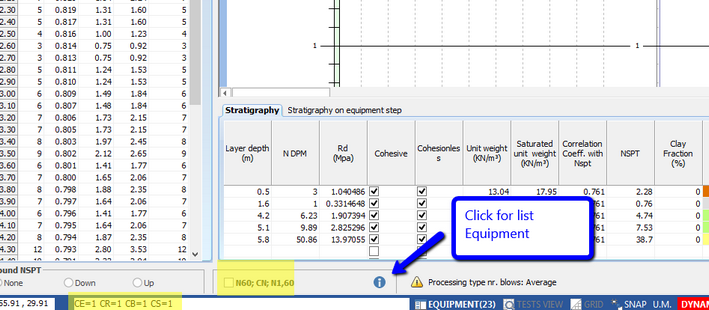Computation of N1, 60
The most recent empirical correlations of NSPT, relative density and angle of shearing resistance of granular are calculated using the penetration resistance in terms of N60 (NSPT=N60 according to Cestari, 1996) or of N1,60, normalized value at a geostatic vertical pressure of 1 bar by applying the coefficient CN (Liao and Withman 1986).
N60=NSPT*CE
N60: Value of corrected NSPT for an efficiency of 60% (according to Cestari N60=NSPT)
CE=ER/60
The energies of the different systems vary from 45% to 98%
N1,60= NSPT*CE*CN*CR*CB*CS
CN=(Pa/σ’v)1/2 Liao and Withman ( 1986)
pa=atmospheric pressure = 98.1
CN=2/(1+σ'v/100) Skempton (1986) Fine sands
CN=3/(2+σ'v/100) Skempton (1986) Coarse sands
Normalization at an effective stress of 100 Kpa (1 Kg/cm2)
CN: Overburden correction factor
CE: Energy correction factor
CR: Rod length correction factor
CB: Bore-hole diameter correction factor
CS: Liner correction factor
ER: Hammer energy transfer ratio according to ASTM D-4633-86
CN in practical application cannot exceed 2 and preferably not exceed 1.5. The correction of CN is applied only for the computation of relative density and angle of shearing resistance, and is not applied to the computation of the undrained parameters and deformation parameters.
RELATIVE DENSITY
Dr=(N1,60/A)1/2 Skempton (1986)
A: variable constant between 55-65 from fine sands to coarse sands.
The parameter A is expressed according to Cubrinowski and Ishihara (1999-2000) as a function of the difference between the maximum and minimum void ratio.
A=9/(emax-emin)1.7
The variation fields of (emax-emin) are taken from Das et al. (2012) for clean sands and silty sands, while for gravel reference can be made to data reported by Jamiokowakj and Lo Presti (2003)
emax-emin=0.19-0.29
ANGLE OF SHEARING RESISTANCE
The most used correlations in the last years, as reported NCHRP (2010) are:
| φ’=54-27.6034*exp(-0.014*N1,60) | Kulhawy & Mayne (1990) |
| φ’=(20*N1,60)0.5+20 | [for N1,60=3.5-30] Hutanaka & Uchida (196) |
| φ’=27.1+0.3*N1,60-0.00053*N1,60 | Wolff (1989) |
| φ’=(15.4*N1,60)0.5+20 | Mayne et al. (2001) |
| φ’=(15*N1,60)0.5+15 | [for N1,60>5 φ<45] JRA (1996) |
An interpolating correlation of the average values of φ is defined with the following equation:
φ=20.1* N1,600.2
Recently Brown and Hettirachchi (2008) use more precautionary values for the angle of shearing resistance compared with the previous ones that can be assimilated approximately to the constant volume friction angle that is to the shearing resistance in critical conditions in correspondence of which further deformations occur without volume variation:
φ’=0.3818*tan-1(24.525*N60/σ’)
TO PERFORM THE COMPUTATION OF N60, N1,60:
